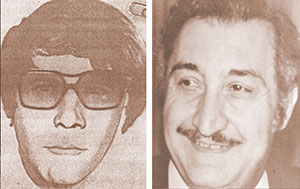
The release of formerly withheld case files by the FBI is shedding light on the notorious 1982 killing of Turkish diplomat Orhan Gündüz in Somerville. — Photo courtesy of MuckRock
By Michael McHugh
Forty years ago, in the Spring of 1982, Somerville Police Officers arrived at the intersection of Webster Avenue and Newton Street to a chaotic scene of residents and journalists crowded around a crashed vehicle. The bloodied, bullet-ridden car contained the body of Turkish diplomat and businessman Orhan Gündüz, assassinated in broad daylight during his drive home.
And while the scene was far from an ordinary sight, it was unlikely that they knew this would be the beginning of a decades-long manhunt in which no culprit was ever found and few answers would ever be brought to light. “I’m calling on behalf of the Justice Commandos of the Armenian Genocide,” an anonymous caller told the Los Angeles Bureau of United Press International not long after the attack, “We just shot the Turkish consul in Boston, Massachusetts. This is our style. We will strike again.”
Despite the seemingly overwhelming evidence, including the murder weapons, several witnesses, a crystal-clear motive, and the discarded jogging suit worn by the killer as well as their car, the case has remained unsolved by the FBI for 40 years. However, just this year, MuckRock journalists Gabriella Gage and Tom Nash have made a breakthrough in their 9-year-long investigation into the killing, with over 3,8000 never before seen pages of FBI files finally published as a result of their long-standing, repeated requests for information.
“I just couldn’t believe there was so little information about it,” said Gage “I grew up in Union Square, and just the fact that so many people who live here now don’t know that this event took place, and that it is rooted in intergenerational trauma for both [Turkish and Armenian] communities, [led to me] obviously wanting to find out as much as I could about this.”
The story they found within the paper trail showed that the FBI had made investigating this attack one of their top priorities. Identifying culprits, hypnotizing witnesses for more information, utilizing a network of high-risk informants, and starting a multistate gun trace on the murder weapons were all done by the FBI in a desperate attempt to make sure that Orhan Gündüz would be the last victim of the Justice Commandos of the Armenian Genocide.
Twenty-one Turkish diplomats had already been killed since 1975, JCAG invoked the Turkish genocide of 1.5 million Armenians and subsequent denial and lack of recognition by the Turkish government and the US, whose president would not formally recognize the violence as genocide until 2021. This lack of formal recognition would become a motivating factor for radical, often young Armenians who were frustrated with Turkish and US governments to take action.
Thanks to the newly released FBI files, it is now clear that the FBI were going to great lengths to prevent another attack. And while they would never find the one responsible for Gündüz’s murder, their subsequent investigation into JCAG would contribute to the militant organization’s eventual dissolvement and would lead to the prevention of a JCAG bombing with the potential to be one of the deadliest in US history.
Sources warned that JCAG would make an attempt to detonate an explosive in the Philadelphia Turkish Consulate, given the building was made entirely of glass and was located in a densely populated area, predictions indicated that up to 3,000 people could be wounded or killed if the attack were to be successful. Thankfully, the “Fauxbom” plot was stopped when the FBI arrested five suspects, unfortunately none of whom could at the time be connected to Gündüz’s killing beyond their involvement in JCAG.
Information surrounding the killing would slow after the initial explosion of press. Somerville residents who had seen the gruesome images of the slaying in their newspapers wouldn’t receive any further answers to how this could have happened. Somerville being the home of the infamous Winter Hill Gang, residents understood that speaking out as a witness, especially in the case of organized crime such as this, could cost them their life.
“There was not a lot of incentive to get involved or possibly endanger yourself with trained assassins,” explained Gage, “I think people recognized that these people weren’t messing around, and I think there’s definitely truth to the fact that people got quiet very quickly.”
The Boston Herald even reported that a man claiming to be a witness to the murder was shot and hospitalized near the crime scene some months later. This story would never be corroborated beyond the article, but the effect on resident’s willingness to act as witnesses was nevertheless real.
And without the surveillance technology present in our everyday lives today, investigators had limited resources to separate fact from fiction and understand what had truly happened. “This sort of thing just couldn’t happen today,” said Nash, “you couldn’t shoot someone in the middle of Union Square and get away with it. Union Square has like seven different police cameras pointed at it right now.”
To the many residents who knew Orhan Gündüz, complete closure or answers relating to the death of their friend and pillar of the community would remain out of reach. Having waited long enough, the thousands of pages of FBI files released to the public just this year may contain some of the answers that they were looking for.
“We really want to have full transparency and give anyone who wants to look into this the tools to know what we know and to understand this as much as possible,” said Gage, “We’re sharing all the files. So if you want to spend a week reading a 2,000 page file on this, you can dive in and maybe you’ll find something new.”
As much as this breakthrough is a sign of more answers to come, thousands of unreleased files relating to Gündüz and requested by Gage and Nash remain undisclosed. “A lot of this story is just figuring out what the FBI has, and why won’t they just release it?” explains Nash.
The over 3,800 pages of documents relating to the investigation can be located on the non-profit news site, MuckRock: www.muckrock.com.















Reader Comments